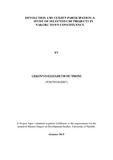| dc.description.abstract | Kenya has for a long time embraced different strategies of exercising development. After a
long time of centralized development administration, devolution was embraced. At the heart
of devolution is the control of resources by local communities with the patronage of a
representative that they feel they can have access to. The Constituency Development Fund
(CDF) was institutionalized in 2003 after a new administration came to power. Although this
programme has been lauded as a success, it requires that people participate for it to achieve
its objectives.
This paper investigated factors that contribute to differing citizen participation levels in CDF
projects in Nakuru Town Constituency. The specific research objectives were to establish the
level of citizen participation in CDF projects in the study area; to establish how citizens
participate in CDF projects in the study area; and to establish how local institutions enhance
citizen participation in Nakuru town constituency.
The study was conducted in Nakuru town constituency, identified because of its unique
features including its high population and its political history of changing Members of
Parliament (MP) who are the patrons of the CDF fund. The research design used was
structured interviews with primary respondents, key informant interviews with CDF project
officials, desk reviews for ascertaining data, as well as direct observation methods. The study
used a sampling frame that identified projects with similar characteristics. These were listed
to allow for sampling. Purposive sampling was used to identify respondents for the Key
Informant Interviews. Random sampling was used to identify primary respondents. The data
collection tools used included questionnaires, unstructured interviews and literature review.
In analyzing the field data, descriptive and inferential statistics were used. Analysis of
qualitative information complimented the quantitative data.
The study found that there were low citizen participation levels. Participation levels were
highly affected by the demographic characteristics of sex, age, marital status as well as
education levels. Citizen participation also differed based on the different stages of the
project cycle. Most of the people participated in the feedback after the project while the least
contributed at the inception stages. Local institutions of the CDF, namely the CDFC and the
Project Management Committee, are very instrumental in people participation. However,
they have not done enough to encourage citizen participation despite the fact that people feel
they have the potential to encourage them to participate.
The study concluded that citizen participation has been low. This includes low contributions
of time, money, labour, ideas at both the different levels of the project cycle as well as in
different projects. Finally, CDF institutions were equally noted not to enhance people’s
participation. The study recommends well thought out structures to encourage citizen
participation as well as alternative patronage of the CDF in order to alienate local
development from the present perception of the fund being a token for citizen’s who work
well with the Member of Parliament. A further scope for research was identified in
establishing factors that can create sustainability of local development projects. | en_US |

